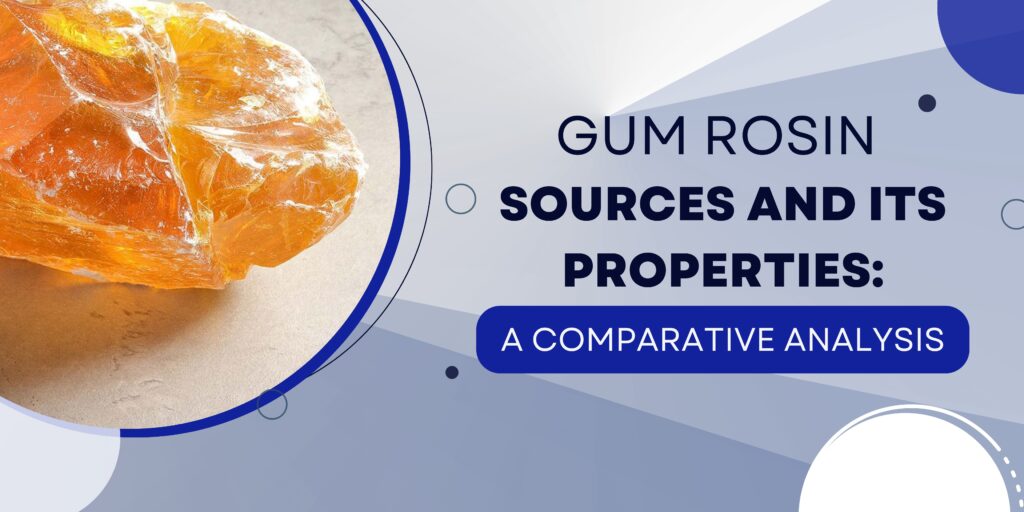
Black gum rosin, a natural resin derived from liquidambar trees, holds a rich history of diverse applications spanning various industries. In this comprehensive guide, we delve into the origins, extraction methods, and wide-ranging uses of black gum rosin. From its historical significance to its contemporary applications in industrial, medicinal, and artistic realms, this article aims to provide an in-depth understanding of this versatile natural resource.
Origins of Black Gum Rosin
Natural Habitat and Liquidambar Trees
Liquidambar trees, particularly the species known as Liquidambar styraciflua, are the primary source of black gum rosin. Native to North America, these deciduous trees are commonly found in various regions, each characterized by specific environmental conditions that contribute to the production of this valuable natural resin.
Historical Significance
The historical significance of black gum rosin is deeply embedded in the cultural heritage of societies that have utilized it for centuries. Black gum rosin has been a staple in traditional medicine, and this subsection examines its historical use in folk remedies. Artisans and craftsmen have historically valued black gum rosin for its unique properties in artistic endeavors. Whether in woodworking, varnish making, or sculpting, the resin has played a crucial role in shaping traditional crafts.
Extraction Methods
Traditional Extraction Techniques
The extraction of black gum rosin through traditional methods is a practice deeply rooted in history, which was extracted through labor-intensive methods.
Tapping Liquidambar Trees
One of the primary traditional methods of extracting black gum rosin involves tapping liquidambar trees. Harvesters would make incisions in the bark, allowing the resin to seep out slowly. This labor-intensive process required a keen understanding of the tree’s growth patterns and optimal tapping locations. The collected resin was then typically scraped off the tree and collected for further processing.
Hand Collection
Before the advent of sophisticated tools, black gum rosin extraction often involved manual labor. Harvesters would directly collect resin from the tree using hands or simple tools. This method required a delicate touch to avoid damaging the tree and to ensure the quality of the resin collected. Hand collection was a meticulous process that demanded experience and skill.
Resin Scraping and Collection
Once the resin emerged from the tapped areas or was manually collected, it needed to be carefully scraped off the tree’s surface. Harvesters used tools such as spatulas or knives to gather the resin without causing harm to the tree. The collected resin, often in its raw and impure form, would be further processed to refine its quality.
Modern Extraction Processes
Over time, advancements in extraction techniques have been developed to enhance efficiency, yield, and sustainability. In modern extraction processes, machinery and technology play a significant role. Mechanical extraction involves the use of specialized equipment designed to streamline the collection of black gum rosin from liquidambar trees. This may include automated tapping devices that can efficiently harvest resin without causing harm to the trees. These devices are designed to optimize the extraction process, ensuring a higher yield while minimizing environmental impact.
Chemical Composition and Properties
Chemical Components of Black Gum Rosin
1. Resin Acids
Black gum rosin is characterized by the presence of resin acids, which are organic acids responsible for many of its beneficial properties. Common resin acids found in black gum rosin include abietic acid, neoabietic acid, and palustric acid.
2. Esters
Esters, derived from the reaction between resin acids and alcohols, are essential components of black gum rosin. These compounds contribute to the resin’s chemical stability and play a role in various applications, including adhesives and coatings.
3. Terpenes and Hydrocarbons
Black gum rosin contains terpenes and hydrocarbons, which contribute to its aromatic nature. These compounds not only influence the resin’s scent but also play a role in its solubility and overall chemical behavior.
4. Stabilizers and Additives
Depending on the source and processing methods, black gum rosin may contain stabilizers and additives. Understanding these additional components is crucial for assessing the purity and quality of the resin in specific applications.
5. Polymerization Potential
The chemical components of black gum rosin contribute to its polymerization potential. Polymerization is the process by which the resin forms larger molecular structures, affecting its physical properties and suitability for various industrial uses.
Physical Properties
1. Color
Describing the color of black gum rosin is fundamental. The resin may range from pale yellow to dark brown or even black. Exploring the factors influencing color, such as tree age, environmental conditions, and processing methods, helps to provide a nuanced understanding.
2. Texture and Consistency
Examining the texture of black gum rosin involves describing its physical state, whether it is solid, semi-solid, or has a sticky consistency. Understanding the variations in texture is crucial for industries like adhesives and inks where specific consistencies are required for optimal performance.
3. Melting Point
The melting point of black gum rosin is a critical parameter. It influences its usability in various applications, particularly in industries like adhesives and coatings. Detailing the temperature range at which the resin transitions from a solid to a liquid state is important for manufacturing processes.
4. Solubility
Discussing the solubility of black gum rosin in different solvents provides insights into its compatibility with various formulations. This information is valuable for industries such as pharmaceuticals and cosmetics, where solubility is a key factor in product development.
5. Odor
Describing the odor of black gum rosin is significant, as it may have a distinct fragrance. Understanding the aroma can be important in applications like perfumery and certain traditional crafts where scent plays a role.
6. Density
Examining the density of black gum rosin involves determining its mass per unit volume. This physical property is crucial in understanding the resin’s overall weight and can influence dosage considerations in various applications.
7. Transparency
Some forms of black gum rosin may have varying degrees of transparency. Understanding how light interacts with the resin can be relevant in industries such as optics or in applications where visual aesthetics are important.
8. Crystalline Structure
Exploring the crystalline structure of black gum rosin can provide insights into its molecular arrangement. This information is essential for understanding the resin’s stability and behavior under different conditions.
9. Hygroscopicity
Investigating the hygroscopic nature of black gum rosin, i.e., its ability to absorb moisture from the surroundings, is crucial in applications where moisture content can impact performance, such as in certain adhesive formulations.
Industrial Applications
Adhesive Formulations
Black gum rosin serves as a fundamental ingredient in the formulation of adhesives, contributing to its adhesive and cohesive properties. The resin’s tackiness and ability to bond various materials make it a key component in the adhesive industry.
Printing Inks and Coatings
The chemical composition and physical properties of black gum rosin contribute to the viscosity, drying time, and glossiness of printing inks. Beyond inks, black gum rosin is integral to the formulation of coatings applied to surfaces for protection and aesthetics.
Biodegradable Plastics
In response to the growing environmental concerns, the industrial sector is increasingly adopting sustainable practices. Black gum rosin emerges as a key player in this shift, particularly in the realm of biodegradable plastics.
Medicinal and Therapeutic Uses
Traditional Medicine
The historical use of black gum rosin in traditional medicine spans diverse cultures and regions. Indigenous communities have revered this natural resin for its perceived healing properties. Black gum rosin has been employed in various folk remedies, poultices, and salves to address a wide array of ailments.
Throughout history, indigenous healers and herbalists have harnessed the anti-inflammatory and antimicrobial attributes of black gum rosin. Its traditional use includes topical applications for wound healing, skin conditions, and joint discomfort. Moreover, the resin has been incorporated into herbal formulations to address respiratory issues and promote overall well-being.
Modern Medicinal Applications
In the contemporary era, scientific research has increasingly focused on unlocking the therapeutic potential of black gum rosin. The resin’s complex chemical composition, including resin acids and esters, has drawn the attention of researchers exploring its pharmacological properties.
Studies have investigated the anti-inflammatory and analgesic effects of black gum rosin, suggesting its potential as a natural remedy for conditions involving inflammation and pain. Additionally, research has explored its antimicrobial properties, hinting at possible applications in addressing infections and supporting immune function.
The resin has found its way into various modern medicinal formulations, including ointments, balms, and creams designed to alleviate joint and muscle discomfort. Furthermore, pharmaceutical researchers are exploring the incorporation of black gum rosin extracts in novel drug formulations, expanding its potential therapeutic reach.
As ongoing research continues to uncover the nuanced benefits of black gum rosin, it holds promise as a complementary or alternative therapeutic option. Its natural origins and historical precedence make it an intriguing subject for further investigation in the realm of modern medicine.
Environmental Impact and Sustainability
Sustainable Harvesting Practices
The extraction of black gum rosin is intricately connected to the health and vitality of liquidambar tree populations. Sustainable harvesting practices are essential to ensure the longevity of these trees and minimize the environmental impact of rosin extraction. Traditional methods, such as tapping, involved making incisions in the tree bark to collect resin. While effective, excessive or improper tapping can harm the trees, affecting their growth and overall health.
Modern sustainable harvesting practices aim to strike a delicate balance between meeting the demand for black gum rosin and preserving the integrity of liquidambar tree ecosystems. This involves adopting methods that reduce stress on individual trees, such as rotational tapping and controlled resin extraction. By allowing trees time to recover between harvests, sustainable practices promote healthier and more resilient liquidambar populations.
Additionally, efforts are underway to integrate technology into sustainable harvesting. Remote sensing and monitoring tools are employed to assess tree health, resin production, and overall ecosystem impact. These innovations contribute to more informed decision-making, ensuring that the extraction of black gum rosin aligns with the principles of environmental stewardship.
Eco-friendly Applications
The environmental impact of black gum rosin extends beyond the extraction process to its diverse applications in various industries. One notable contribution lies in the development of eco-friendly materials and products. As the world seeks alternatives to traditional, non-biodegradable materials, black gum rosin emerges as a sustainable solution.
In the realm of plastics, black gum rosin has found a valuable role in the formulation of biodegradable and compostable materials. Its compatibility with other bio-based polymers allows for the creation of plastics that break down naturally over time, reducing the burden on landfills and ecosystems. This eco-friendly approach addresses the growing concerns associated with plastic waste and aligns with global efforts to transition towards more sustainable materials.
Furthermore, the use of black gum rosin in the formulation of environmentally friendly adhesives and coatings contributes to reducing the environmental footprint of these products. As industries embrace the principles of circular economy and responsible manufacturing, the adoption of black gum rosin in these applications showcases its potential to drive positive change in the broader context of sustainability.
Conclusion
In conclusion, the comprehensive exploration of black gum rosin has unveiled a natural resource with a profound impact on various industries and cultural practices. From its historical roots in traditional medicine and craftsmanship to its modern applications in adhesives, inks, and biodegradable plastics, black gum rosin stands as a testament to the adaptability and versatility of nature’s offerings. The careful examination of its origins, extraction methods, and chemical composition has provided a holistic understanding of this resin’s significance, both historically and in the context of contemporary environmental challenges.
Moreover, as we navigate an era of increased environmental consciousness, the sustainable harvesting practices and eco-friendly applications associated with black gum rosin exemplify its pivotal role in fostering a greener future. By prioritizing the health of liquidambar tree ecosystems through responsible extraction methods and leveraging the resin’s properties in the development of biodegradable materials, the industry can champion both ecological preservation and technological innovation. Black gum rosin, with its rich history and promising prospects, symbolizes the harmonious integration of tradition and sustainability, paving the way for a more environmentally conscious and resilient tomorrow.




